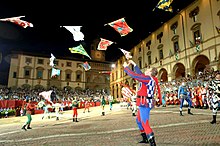Flag throwing
This article includes a list of references, related reading, or external links, but its sources remain unclear because it lacks inline citations. (December 2015) |
You can help expand this article with text translated from the corresponding article in Italian. (March 2021) Click [show] for important translation instructions.
|

Flag throwing, known in the USA as "color guard" and in Italy as "sbandieratore" is considered both an art and a sport combined. Historically, it would accompany military or marching bands, however it has now become a competitive sport in its own right.
History
[edit]The origins of flag throwing are difficult to pinpoint - it has possible roots in Roman, Babylonian and Assyrian history [1]. It was popular with medieval guilds (principally in Italy, Germany, Switzerland, Flanders, and Southern Netherlands) for use during times of war, to allow troops to communicate to each other accross thr battleground. A guild's banner or flag was considered a symbol of purity, and as such it was not allowed to touch the ground.[2] After a battle was won, flag bearers, along with military bands, would take part in victory parades on their return home.
Today, flag throwing is part of many traditional festivals in Italy, such as Siena's Palio. [3] It is also a popular sport in schools in the USA, where it is known as "color guard". Color guard is practiced along with marching bands.
References
[edit]External links
[edit]- Federazione italiana Sbandieratori The Italian official flag throwing federation.
- Lega italiana Sbandieratori The Italian flag-throwing league.
- Flag throwing, on Flags Of The World website.
- SbandierAutori – An Italian book on the flag throwers tradition
- Alfieri's "La Bandiera" – Information on Francesco Alfieri's treatise on flag waving, 'La Bandiera', published in 1638

